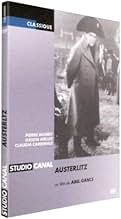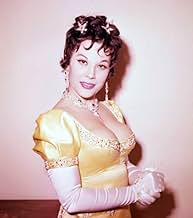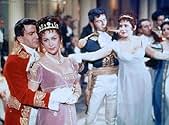Austerlitz
- 1960
- Tous publics
- 2h 46min
NOTE IMDb
6,2/10
1 k
MA NOTE
Ajouter une intrigue dans votre langueAnother of Napoleon's adventures in this epic reconstruction of the battle of Austerlitz, where he had the greatest victory of his career, over the Russians.Another of Napoleon's adventures in this epic reconstruction of the battle of Austerlitz, where he had the greatest victory of his career, over the Russians.Another of Napoleon's adventures in this epic reconstruction of the battle of Austerlitz, where he had the greatest victory of his career, over the Russians.
- Réalisation
- Scénario
- Casting principal
- Récompenses
- 1 nomination au total
Avis à la une
Abel Gance's unabashed adoration of Napoléon Bonaparte bore fruit in one of the undisputed masterpieces of silent cinema. Thirty-four years later he again depicts his hero in a film that is totally devoid of the flair and dazzling inventiveness of the earlier work. He is assisted by Roger Richebé who had directed Gance's original Napoléon, Albert Dieudonné, in that actor's second outing in the role in 'Madame sans-gene.' Here he is played by Pierre Mondy.
One is impressed by the art direction, costume design and the beautifully shot series of tableaux vivants by Messieurs Alekan and Juillard but alas the whole enterprise is verbose, bombastic, self-indulgent and uninspired and fails to justify its lumbering two and three-quarter hour length.
Most of the males are marionettes with the notable exceptions of Welles, Marais, Trintignant and Marchal whilst grizzled Michel Simon does an outrageous turn as one of Napoléon's Old Guard. Plenty of cleavage on display and an enchanting cameo by Leslie Caron as one of Bony's extra-marital activities. The most ludicrous piece of casting is that of Jack Palance as an Austrian General. As Pope Pius V11 an utterly expressionless Vittorio de Sica calls Bonaparte ' a comedian' which pretty well sums up Pierre Mondy's portrayal.
Regarding Monsieur Gance's output I think it fair to say that 'silence is golden.'
One is impressed by the art direction, costume design and the beautifully shot series of tableaux vivants by Messieurs Alekan and Juillard but alas the whole enterprise is verbose, bombastic, self-indulgent and uninspired and fails to justify its lumbering two and three-quarter hour length.
Most of the males are marionettes with the notable exceptions of Welles, Marais, Trintignant and Marchal whilst grizzled Michel Simon does an outrageous turn as one of Napoléon's Old Guard. Plenty of cleavage on display and an enchanting cameo by Leslie Caron as one of Bony's extra-marital activities. The most ludicrous piece of casting is that of Jack Palance as an Austrian General. As Pope Pius V11 an utterly expressionless Vittorio de Sica calls Bonaparte ' a comedian' which pretty well sums up Pierre Mondy's portrayal.
Regarding Monsieur Gance's output I think it fair to say that 'silence is golden.'
This movie exemplifies the debt that French cinema owes to theater. And, it shows how it can crumble under it.
One cannot say that this movie is badly made, lazy or uninspired. Yet, I did not feel the grandeur of this historic episode as I think it was intended. The movie is not boring or flat. However, for a film that covers the most brilliant victory of a legendary general, it feels a bit toothless.
The film spends the first half carefully laying out the situation and issues that led Napoleon to crown himself emperor. I would say that it is rather static, and feels like a play. It is dialog-heavy. I am not sure why Mondy was chosen as Napoleon. He looks convincing in most of it, yet he does a lot of yelling, which does not give off a statesman-like quality. It does not really capture the heft of it. The film is also heavy on intrigue and personal drama, it can feel tedious if you're not into French history. Some important events happen off-screen; it is harder to keep being engaged with what is happening.
My favorite scene happens as an act-break of sorts, roughly at the middle, it is Napoleons coronation. It is off-screen as well, but it is represented in form of house staff following the ceremony in parallel; at the palace not the church, with the help of rehearsal miniatures. That is where Gances talent shines. It is the best stuff in the movie and it is very clever and inventive. I suspect that it was done this way because filming the actual re-enactment of the ceremony would have been too expensive/difficult. Yet, it totally works. It treats an event that is big, extravagant, symbolic in something more intimate. The scene encapsulates something more classical. Because it focuses not on Napoleon, the pope or the dignitaries, but on the house staff reactions, you get something sweetly human. It is the reaction of the common folk, the little people. One of his aides provides a voice-over that turns the scene into something very poetic, almost Communion-like. It makes it very solemn and dignified. The immobile lifeless miniatures tie the scene in a very iconic, clean, divine bow.
Generally, you get that this film serves as an update to Gances own Napoleon. In that sense, it would serve as an example that less is more. The previous film was regarded, and still is, as one of the most inventive and important of the silent era. Here, you can feel that with the use of sound, dialog, color and the ability to film battles and impressive set-pieces; you are losing the essence of Napoleon: the persona. The strength of the film Napoleon was the visuals and the sense of distant majestic dignity it conveyed. In Austerlitz, despite sound and color, you lose the striking visual poetry. You are left with more precise plot points, but less evocative characters.
One cannot say that this movie is badly made, lazy or uninspired. Yet, I did not feel the grandeur of this historic episode as I think it was intended. The movie is not boring or flat. However, for a film that covers the most brilliant victory of a legendary general, it feels a bit toothless.
The film spends the first half carefully laying out the situation and issues that led Napoleon to crown himself emperor. I would say that it is rather static, and feels like a play. It is dialog-heavy. I am not sure why Mondy was chosen as Napoleon. He looks convincing in most of it, yet he does a lot of yelling, which does not give off a statesman-like quality. It does not really capture the heft of it. The film is also heavy on intrigue and personal drama, it can feel tedious if you're not into French history. Some important events happen off-screen; it is harder to keep being engaged with what is happening.
My favorite scene happens as an act-break of sorts, roughly at the middle, it is Napoleons coronation. It is off-screen as well, but it is represented in form of house staff following the ceremony in parallel; at the palace not the church, with the help of rehearsal miniatures. That is where Gances talent shines. It is the best stuff in the movie and it is very clever and inventive. I suspect that it was done this way because filming the actual re-enactment of the ceremony would have been too expensive/difficult. Yet, it totally works. It treats an event that is big, extravagant, symbolic in something more intimate. The scene encapsulates something more classical. Because it focuses not on Napoleon, the pope or the dignitaries, but on the house staff reactions, you get something sweetly human. It is the reaction of the common folk, the little people. One of his aides provides a voice-over that turns the scene into something very poetic, almost Communion-like. It makes it very solemn and dignified. The immobile lifeless miniatures tie the scene in a very iconic, clean, divine bow.
Generally, you get that this film serves as an update to Gances own Napoleon. In that sense, it would serve as an example that less is more. The previous film was regarded, and still is, as one of the most inventive and important of the silent era. Here, you can feel that with the use of sound, dialog, color and the ability to film battles and impressive set-pieces; you are losing the essence of Napoleon: the persona. The strength of the film Napoleon was the visuals and the sense of distant majestic dignity it conveyed. In Austerlitz, despite sound and color, you lose the striking visual poetry. You are left with more precise plot points, but less evocative characters.
Austerlitz (1960) was the battle that made Napoleon Bonaparte not only one of western civilization's greatest generals, but it solidify his position as Napoleon I "The Emperor of France". I saw this film many years ago on video. The colors were washed out and it was cropped big time. Besides these faults, the movie was great. If there's a movie that needs to be restored it's this one. A film of this magnitude and the grand scale it was presented on needs to be shown it is original glory.
NAPOLEON was restored recently. It's only fitting that the film that the same director spent his entire life on have one of it's sequels be remastered and preserved in the same way.
Highly recommended.
NAPOLEON was restored recently. It's only fitting that the film that the same director spent his entire life on have one of it's sequels be remastered and preserved in the same way.
Highly recommended.
I was under the impression for ages that Abel Gance only made one Napoleon film (all the way back in 1927), and that he wanted to make five or six, but never got the chance. It turns out this isn't entirely true. Not only is Napoleon (1927) long enough to be two or three films in one (it's like 5.5 hours long), but Gance got to make a sort-of sequel in 1960, with the also epic-length The Battle of Austerlitz.
This 1960 film is about half the length of Napoleon, but that still puts it at approximately 170 minutes. It also feels like two movies in one, with a lot of political drama being the focus of the first half, and then the second half centering on planning for the titular battle alongside showing some of it.
I thought the second half would be a good deal more engaging, but I think The Battle of Austerlitz starts quite well, staying pretty engaging for maybe the first half of its first half. Things don't necessarily pick up in a big way once the second half starts, though. It's a bit plodding in different ways to the first half, and it becomes apparent at a point that even the battle parts aren't really going to be about depicting exciting battles. If you come in hoping for something similar to the 1966/67 War and Peace or Waterloo, you'll probably come away disappointed.
The methodical approach to it all (across both halves), while dry, is somewhat admirable. Abel Gance isn't doing nearly as many adventurous things with the camera this time around, which can be disappointing after having watched his 1927 film, but I guess there's sound now, and it's a new approach. The transition from making a silent Napoleon film to making a more traditional one with dialogue was more seamless than I'd been anticipating, and Gance would've had to have been fairly old while making this. I think he did a decent job, all things considered.
Still, this is probably just a curiosity piece for those who were intrigued by and liked Napoleon, or just anyone who's interested in any film about Napoleon Bonaparte. There sure are many of them; I keep coming across new ones all the time, and honestly, I don't think I've seen any I could call flat-out bad yet.
This 1960 film is about half the length of Napoleon, but that still puts it at approximately 170 minutes. It also feels like two movies in one, with a lot of political drama being the focus of the first half, and then the second half centering on planning for the titular battle alongside showing some of it.
I thought the second half would be a good deal more engaging, but I think The Battle of Austerlitz starts quite well, staying pretty engaging for maybe the first half of its first half. Things don't necessarily pick up in a big way once the second half starts, though. It's a bit plodding in different ways to the first half, and it becomes apparent at a point that even the battle parts aren't really going to be about depicting exciting battles. If you come in hoping for something similar to the 1966/67 War and Peace or Waterloo, you'll probably come away disappointed.
The methodical approach to it all (across both halves), while dry, is somewhat admirable. Abel Gance isn't doing nearly as many adventurous things with the camera this time around, which can be disappointing after having watched his 1927 film, but I guess there's sound now, and it's a new approach. The transition from making a silent Napoleon film to making a more traditional one with dialogue was more seamless than I'd been anticipating, and Gance would've had to have been fairly old while making this. I think he did a decent job, all things considered.
Still, this is probably just a curiosity piece for those who were intrigued by and liked Napoleon, or just anyone who's interested in any film about Napoleon Bonaparte. There sure are many of them; I keep coming across new ones all the time, and honestly, I don't think I've seen any I could call flat-out bad yet.
My review of this film can be summed up in five words a brilliant work of art.As described in the previous description the film itself is long and sometimes tedious.What it fails to mention is that it was created by the same Director that brought us the Silent film about Napoleon Abel Gance.The film is in colour and is very faithful to the feel of Napoleon and the time he ruled Europe.It is primarily about the greatest victory Napoleon achieved in his career,however it also touches on many of the events in his life leading up to that moment including his coronation as Emperor of France.If you are a student of Napoleon or French history or this time period you will enjoy this picture.Shot all throughout Europe in the fifties in many languages it remains in my opinion as the greatest picture chronicling Napoleon and his life.The film not only tells a story from his perspective but many others as well.It is difficult to find and even more expensive to own but I definitely recommend you see it at least once for yourself.
Le saviez-vous
- AnecdotesIn the 1920s Abel Gance had written a six-part movie biography of Napoleon. He shot the first part (Napoléon (1927)), which turned out to be a financial disaster. He sold the sixth part to Lupu Pick, who shot Sainte-Hélène (1929). Wanting to make a comeback at the end of the 1950s, Gance rewrote the third part to make it "Austerlitz".
- GaffesIn the scene in William Pitt's office in London which is set in the early 1800's, you can see in the background through the window the Houses of Parliament and Big Ben, 60 years before they were built.
- Versions alternativesThe original French version runs longer than the English dubbed international one. It contains extra scenes including ones with Napoleon visiting his mistress and of Ségur (Jean-Louis Trintignant) imagining the coronation of the emperor for the palace staff.
- ConnexionsEdited into Histoire(s) du cinéma: Seul le cinéma (1994)
Meilleurs choix
Connectez-vous pour évaluer et suivre la liste de favoris afin de recevoir des recommandations personnalisées
- How long is The Battle of Austerlitz?Alimenté par Alexa
Détails
- Date de sortie
- Pays d’origine
- Langue
- Aussi connu sous le nom de
- The Battle of Austerlitz
- Lieux de tournage
- Sociétés de production
- Voir plus de crédits d'entreprise sur IMDbPro
Box-office
- Budget
- 4 000 000 $US (estimé)
- Durée2 heures 46 minutes
- Mixage
- Rapport de forme
- 2.35 : 1
Contribuer à cette page
Suggérer une modification ou ajouter du contenu manquant







































